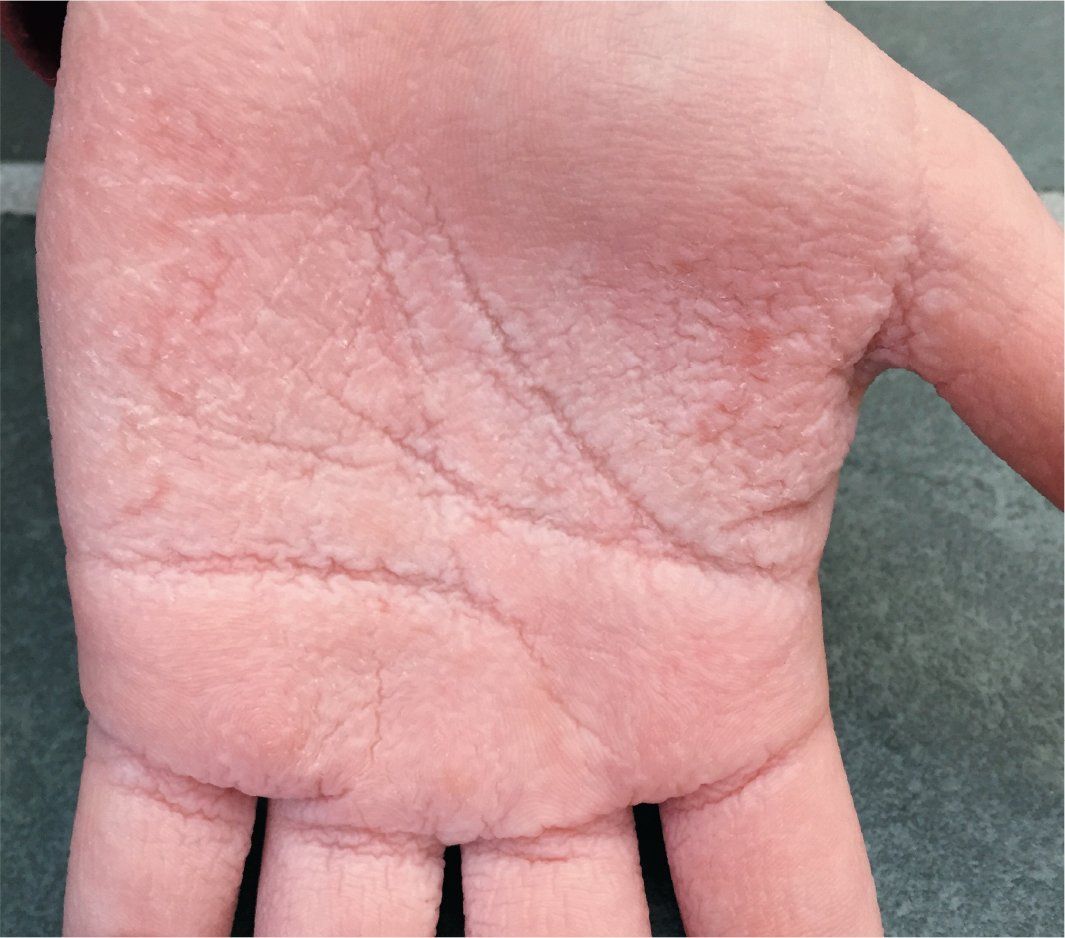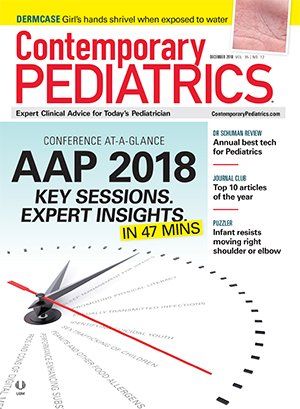Girl’s hands shrivel when exposed to water
A 16-year-old girl presents to the clinic for acne follow-up and mentions that her palms wrinkle significantly after only a few minutes of immersion in water. She is otherwise well and has no significant past medical history.
Patient's palm

The case
A 16-year-old girl presents to the clinic for acne follow-up and mentions that her palms wrinkle significantly after only a few minutes of immersion in water. She is otherwise well and has no significant past medical history.
Diagnosis: Aquagenic wrinkling of palms
Clinical findings
After brief (minutes of) exposure to water, the patient experiences exaggerated wrinkling of the palms along with white, edematous papules that may coalesce into plaques. Upon removal from water, her skin changes typically resolve in less than 1 hour with drying of the skin. Although the diagnosis is made clinically, histology of the skin reveals dilated eccrine ducts.
Etiology/Epidemiology
Aquagenic wrinkling of the palms (AWP) has a strong association with cystic fibrosis (CF), affecting up to 84% of patients with CF and up to 25% of carriers.1 In patients with CF, aquagenic wrinkling typically develops faster (within 2 to 3 minutes of immersion in water) than in carriers (5 to 7 minutes).
The mechanism responsible for this phenomenon is not fully understood. However, it is thought that the increased tonicity of sweat in patients with CF induces an osmotic shift of water across the epidermis.2 Because mutations in the gene encoding the CF transmembrane conductance regulator (CFTR gene) protein are responsible for the pathologic dysregulation of epithelial fluid transport in CF, CFTR-directed therapies have been successful in improving pulmonary function and other clinical outcomes for some patients.3 Interestingly, pharmacologic therapy for CF that potentiates CFTR function also has been shown to reduce aquagenic wrinkling.
Whereas AWP is most prominently described in association with CF, there have been reports of AWP in healthy individuals as well as in patients with marasmus and atopic dermatitis.4 Certain drugs (eg, selective cyclooxygenase-2 (COX-2) inhibitors, nonsteroidal anti-inflammatory drugs (NSAIDS), angiotensin-converting enzyme (ACE) inhibitors, and angiotensin II receptor blockers (ARBs) also may be associated with cases of aquagenic wrinkling by causing dysregulation of aquaporins and abnormal water transport across cell membranes in the skin.2
Differential diagnosis
Hyperhidrosis is a condition of unknown etiology characterized by excessive sweating that is generally localized to local body region (ie, palms). It can affect patients of any age but is most commonly seen in adolescents and young adults. Although palmar hyperhidrosis has been associated with the development of AWP,5 the former is a distinct disorder with much higher prevalence and is not known to have association with CF.
Hereditary papulotranslucent acrokeratoderma (HPA) is a congenital disorder characterized by yellow-white papules and plaques at the borders of the palms and soles.6 However, normal eccrine glands are seen on biopsy. In contrast, skin changes in AWP occur transiently in response to water exposure and involve dilated eccrine glands on histology.
Treatment and management
Aquagenic wrinkling of the palms itself is benign and can be prevented by water avoidance. Severe cases can be treated with a topical antiperspirant (eg, aluminum chloride).
In this patient, AWP was an isolated finding without accompanying symptoms or family history suggestive of CF. However, reports have shown that AWP can be the first presenting sign of CF carrier status in otherwise healthy individuals, or of nonclassical CF that involves fewer organ systems and that is often diagnosed later in life.1 Given this finding, the patient was referred for sweat chloride testing.
Patient outcome
With the patient’s sweat chloride level of 26 mmol/L (reference range: 0-29), she was categorized as “cystic fibrosis unlikely.” Although there have been cases of CF patients and carriers with normal sweat chloride tests, a previous study did not recommend genetic testing for patients with isolated aquagenic wrinkling without symptoms related to, or family history of, CF.6 This was consistent with recommendations from the pediatric Pulmonary Service.
Conclusions
Given the high prevalence of AWP in patients with CF and its association with gene mutation carriers, AWP should prompt preliminary workup for CF.
A careful history should be elicited for family history of CF and associated symptoms (eg, chronic fatigue, diabetes mellitus, nutritional deficiencies, recurrent pancreatitis, diarrhea, acholic stools, bowel obstructions, nasal polyps, chronic sinusitis, chronic coughing, wheezing).6 Digital clubbing on exam may also suggest pulmonary disease.
The index of suspicion based on history and exam may then guide management toward the sweat chloride test or more definitive genetic testing.
References:
1. Thomas JM, Durack A, Sterling A, Todd PM, Tomson N. Aquagenic wrinkling of the palms: a diagnostic clue to cystic fibrosis carrier status and non-classic disease. Lancet. 2017;389(10071):846.
2. Arkin LM, Flory JH, Shin DB, et al. High prevalence of aquagenic wrinkling of the palms in patients with cystic fibrosis and association with measurable increases in transepidermal water loss. Pediatr Dermatol. 2012;29(5):560-566.
3. Grasemann H, Ratjen F, Solomon M. Aquagenic wrinkling of the palms in a patient with cystic fibrosis. N Engl J Med. 2013;369(24):2362-2363.
4. Chinazzo C, De Alessandri A, Menoni S, Romanisio G, Rebora A, Rongioletti F. Aquagenic wrinkling of the palms and cystic fibrosis: an Italian study with controls and genotype-phenotype correlations. Dermatology. 2014;228(1):60-65.
5. Gild R, Clay CD, Morey S. Aquagenic wrinkling of the palms in cystic fibrosis and the cystic fibrosis carrier state: a case-control study. Br J Dermatol. 2010;163(5):1082-1084.
6. Park L, Khani C, Tamburro J. Aquagenic wrinkling of the palms and the potential role for genetic testing. Pediatr Dermatol. 2012;29(3):237-242.

Recognize & Refer: Hemangiomas in pediatrics
July 17th 2019Contemporary Pediatrics sits down exclusively with Sheila Fallon Friedlander, MD, a professor dermatology and pediatrics, to discuss the one key condition for which she believes community pediatricians should be especially aware-hemangiomas.